Cycle of Day and Night

Sunset over the ocean

Sunset over the ocean
How does this align with my curriculum?
| Grade | Course | Topic |
|---|
Students explore the cycle of day and night by sorting and classifying pictures, creating images and reading books.
Overview
| Activities | Timing | Student Grouping | Description |
|---|---|---|---|
| Minds-On: Patterns and Cycles | 20 minutes | Large group | Students learn about cycles and patterns. |
| Action: Centre Activities | 15 each (45 minutes total) | Small group | Students participate in centre activities with a group. |
| Consolidation: Show and Share | 20-30 minutes | Large group | Students show and share what they know about day and night. |
This lesson can be done over a few days.
Students will:
- Describe simple cycles and patterning
- Explore the cycle of night and day
Learning Goals
Students will:
- Describe simple cycles and patterning
- Explore the cycle of night and day
Students can:
- Identify icons/events as being patterns, cycles or neither
- Sort and classify images of objects and activities that take place in either day or night into appropriate groupings
- Create images of objects and activities that take place in either day or night
Success Criteria
Students can:
- Identify icons/events as being patterns, cycles or neither
- Sort and classify images of objects and activities that take place in either day or night into appropriate groupings
- Create images of objects and activities that take place in either day or night
This icon indicates potential assessment opportunities.
Observations
- Observe and record anecdotally students’ responses to questions asked about cycles (Minds-on).
- Observe and record anecdotally students’ participation and sharing during the activity centres (Action).
Conversations
- Have conversations with students at each centre about what can be seen and what occurs during day and night (Action).
Products
- Students could submit their Night and Day Spinners (Action).
- Students could complete the Night and Day - Show and Share reproducible (Consolidation).
Evidence of Student Learning
This icon indicates potential assessment opportunities.
Observations
- Observe and record anecdotally students’ responses to questions asked about cycles (Minds-on).
- Observe and record anecdotally students’ participation and sharing during the activity centres (Action).
Conversations
- Have conversations with students at each centre about what can be seen and what occurs during day and night (Action).
Products
- Students could submit their Night and Day Spinners (Action).
- Students could complete the Night and Day - Show and Share reproducible (Consolidation).
Students will:
- Describe simple cycles and patterning
- Explore the cycle of night and day
Learning Goals
Students will:
- Describe simple cycles and patterning
- Explore the cycle of night and day
Students can:
- Identify icons/events as being patterns, cycles or neither
- Sort and classify images of objects and activities that take place in either day or night into appropriate groupings
- Create images of objects and activities that take place in either day or night
Success Criteria
Students can:
- Identify icons/events as being patterns, cycles or neither
- Sort and classify images of objects and activities that take place in either day or night into appropriate groupings
- Create images of objects and activities that take place in either day or night
This icon indicates potential assessment opportunities.
Observations
- Observe and record anecdotally students’ responses to questions asked about cycles (Minds-on).
- Observe and record anecdotally students’ participation and sharing during the activity centres (Action).
Conversations
- Have conversations with students at each centre about what can be seen and what occurs during day and night (Action).
Products
- Students could submit their Night and Day Spinners (Action).
- Students could complete the Night and Day - Show and Share reproducible (Consolidation).
Evidence of Student Learning
This icon indicates potential assessment opportunities.
Observations
- Observe and record anecdotally students’ responses to questions asked about cycles (Minds-on).
- Observe and record anecdotally students’ participation and sharing during the activity centres (Action).
Conversations
- Have conversations with students at each centre about what can be seen and what occurs during day and night (Action).
Products
- Students could submit their Night and Day Spinners (Action).
- Students could complete the Night and Day - Show and Share reproducible (Consolidation).
Materials and Preparation
| Material/Technology/Setting | Quantity |
|---|---|
|
For all centres
|
For student use |
|
Centre Activity 1: Sorting Station
|
1 set per group |
|
Centre Activity 2:
|
1 set per group |
|
1 per student |
|
Centre Activity 3: Story Corner
Alternatively:
|
1 set per group |
|
Consolidation Activity
|
1 per student |
|
For teacher use |
Materials
| Material/Technology/Setting | Quantity |
|---|---|
|
For all centres
|
For student use |
|
Centre Activity 1: Sorting Station
|
1 set per group |
|
Centre Activity 2:
|
1 set per group |
|
1 per student |
|
Centre Activity 3: Story Corner
Alternatively:
|
1 set per group |
|
Consolidation Activity
|
1 per student |
|
For teacher use |
- It is recommended that students participate in the inquiry lesson Why is There Day and Night? in addition to this lesson.
- Familiarize yourself with how the activities are done.
- For Centre 1, print and cut out one or more sets of the day/night images. You may wish to colour and laminate.
For Centre 2, cut enough paper plates in half so that there is one per student. Punch a hole in the top centre of the cut edge of each plate.
Make 1 copy of the Night-Day Spinner Template reproducible [Google doc] [Word doc] [PDF] for each student.
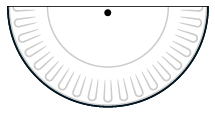
Image - Text Version
Shown is a black and white diagram of half a paper plate, with a hole in the top centre.
The plate is cut in half. The straight, cut edge is across the top of the image. The lower edge is a half circle. In between, the rim and the flat central area of the plate are illustrated with grey lines. At the top, in the centre, is a small black dot.
- Set up materials for centre activities.
Preparation
- It is recommended that students participate in the inquiry lesson Why is There Day and Night? in addition to this lesson.
- Familiarize yourself with how the activities are done.
- For Centre 1, print and cut out one or more sets of the day/night images. You may wish to colour and laminate.
For Centre 2, cut enough paper plates in half so that there is one per student. Punch a hole in the top centre of the cut edge of each plate.
Make 1 copy of the Night-Day Spinner Template reproducible [Google doc] [Word doc] [PDF] for each student.

Image - Text Version
Shown is a black and white diagram of half a paper plate, with a hole in the top centre.
The plate is cut in half. The straight, cut edge is across the top of the image. The lower edge is a half circle. In between, the rim and the flat central area of the plate are illustrated with grey lines. At the top, in the centre, is a small black dot.
- Set up materials for centre activities.
- Working independently at a centre
- Understand what light and dark mean
Student Prior Knowledge and Skills
- Working independently at a centre
- Understand what light and dark mean
| Material/Technology/Setting | Quantity |
|---|---|
|
For all centres
|
For student use |
|
Centre Activity 1: Sorting Station
|
1 set per group |
|
Centre Activity 2:
|
1 set per group |
|
1 per student |
|
Centre Activity 3: Story Corner
Alternatively:
|
1 set per group |
|
Consolidation Activity
|
1 per student |
|
For teacher use |
Materials
| Material/Technology/Setting | Quantity |
|---|---|
|
For all centres
|
For student use |
|
Centre Activity 1: Sorting Station
|
1 set per group |
|
Centre Activity 2:
|
1 set per group |
|
1 per student |
|
Centre Activity 3: Story Corner
Alternatively:
|
1 set per group |
|
Consolidation Activity
|
1 per student |
|
For teacher use |
- It is recommended that students participate in the inquiry lesson Why is There Day and Night? in addition to this lesson.
- Familiarize yourself with how the activities are done.
- For Centre 1, print and cut out one or more sets of the day/night images. You may wish to colour and laminate.
For Centre 2, cut enough paper plates in half so that there is one per student. Punch a hole in the top centre of the cut edge of each plate.
Make 1 copy of the Night-Day Spinner Template reproducible [Google doc] [Word doc] [PDF] for each student.

Image - Text Version
Shown is a black and white diagram of half a paper plate, with a hole in the top centre.
The plate is cut in half. The straight, cut edge is across the top of the image. The lower edge is a half circle. In between, the rim and the flat central area of the plate are illustrated with grey lines. At the top, in the centre, is a small black dot.
- Set up materials for centre activities.
Preparation
- It is recommended that students participate in the inquiry lesson Why is There Day and Night? in addition to this lesson.
- Familiarize yourself with how the activities are done.
- For Centre 1, print and cut out one or more sets of the day/night images. You may wish to colour and laminate.
For Centre 2, cut enough paper plates in half so that there is one per student. Punch a hole in the top centre of the cut edge of each plate.
Make 1 copy of the Night-Day Spinner Template reproducible [Google doc] [Word doc] [PDF] for each student.

Image - Text Version
Shown is a black and white diagram of half a paper plate, with a hole in the top centre.
The plate is cut in half. The straight, cut edge is across the top of the image. The lower edge is a half circle. In between, the rim and the flat central area of the plate are illustrated with grey lines. At the top, in the centre, is a small black dot.
- Set up materials for centre activities.
- Working independently at a centre
- Understand what light and dark mean
Student Prior Knowledge and Skills
- Working independently at a centre
- Understand what light and dark mean
Teaching and Learning Activities
This icon indicates potential assessment opportunities
Minds-On: Patterns and Cycles (20 min.)
| Instructions | Teaching Tips |
|---|---|
|
Show students the What is a Cycle? Slideshow [Google slides] [pptx] [PDF]. Use the titles of the slides as guiding questions and refer to the speaker notes for suggested responses. 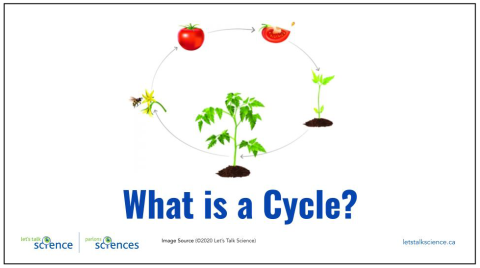
|
Images and VideosDescribe the images in the slideshow for students with visual impairments. In addition, students could be provided with physical objects to interact with that are similar to those used in the slide show. |
Action: Centre Activities (15 min. each = 45 mins. total)
| Instructions | Teaching Tips |
|---|---|
|
Divide students into small groups for centre activities. Activities could be done concurrently or sequentially. Go over the instructions for each centre with the students, demonstrating how each is done. |
IdeaSet a visual timer for each rotation to help students manage their time appropriately. Community ConnectionsIt may be necessary to clarify that the activities are when routines are taking place and not inclusive of religious holidays (eg., those who observe Ramadan eat their dinner at night after the sun has gone down). |
|
Centre Activity 1: Sorting Corner (Night vs Day) Students explore the different symbols associated with night and day. Students will look at the images from Centre Activity 1 Images reproducible [Google doc] [Word doc] [PDF] and determine if the images are related to day or night. The Sorting Mats learning strategy could be used here. |
DiscussionsDiscussion prompts can include:
|
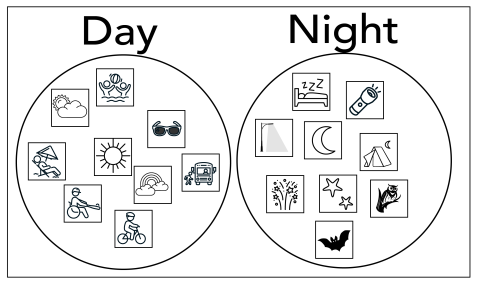
Image - Text VersionShown is a black and white diagram of one circle labelled "Day" and another labelled "Night", filled with illustrated cards. Demonstrate how to sort a few of the cards with the whole class. |
Community ConnectionsConsider incorporating images that are more relevant to the lived experiences of the students in your classroom. IdeaThe use of manipulatives would also be an effective way to engage students. |
|
Centre Activity 2: Craft Corner Students follow the instructions on the Night-Day Spinner Activity Card reproducible [Google doc] [Word doc] [PDF] using the Night-Day Spinner Template reproducible [Google doc] [Word doc] [PDF]. Demonstrate for the students how to do each of the steps. The activity card will act as a visual reminder when doing the activity on their own. A completed spinner can also be provided to students so that they understand what they are to create. Exemplar day-night spinner (©2022 Let’s Talk Science). 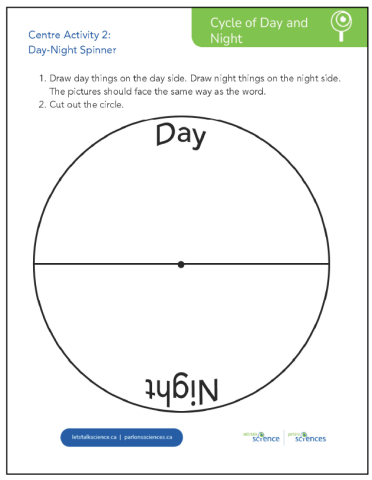
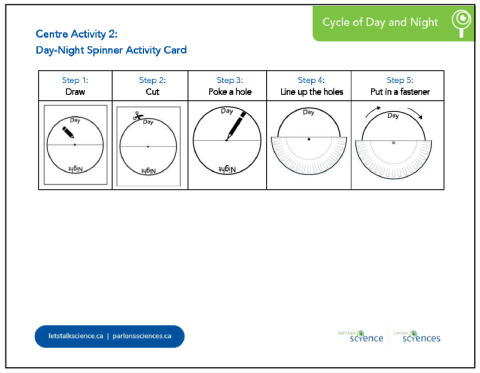
Students should draw images of objects and activities that take place in the day on the day side of the circle and of night on the night side of the circle. |
SafetyStudents may need additional help/supervision when using the sharp pencil to poke holes. IdeaIf spinners are too challenging for students to make, they could use the template to make day-night signs. In this case, they cut the template along the centre line and attach back-to-back with a craft stick in between the layers. Exemplar day-night sign (©2022 Let’s Talk Science). Community ConnectionsThis is a good opportunity for students to share personal and cultural activities that relate to day and night. Those living in Northern communities have a different cycle of night and day due to the 24 hour cycles of darkness and light depending on the season. |
|
Centre Activity 3: Story Corner Listen to the read aloud version of the book Day and Night by National Geographic. Note: For the National Geographic read aloud book, pause the video on the “Your Turn” parts, to allow students to complete the tasks. Alternatively, read Sun Up Sun Down by Gail Gibbons or listen to the read aloud version here to learn about night and day. |
Images and VideosAsk students if they would like to hear/see the video more than once. |
Consolidation: Show and Share 20-30 min.
| Instructions | Teaching Tips |
|---|---|
|
Using the Night and Day - Show and Share reproducible [Google doc] [Word doc] [PDF] have students choose either day or night. Ideally you want about half of the students to choose each. Note: The reproducible has both the day and night versions of the show and share. Print out accordingly and ensure students get the version that corresponds to their choice. 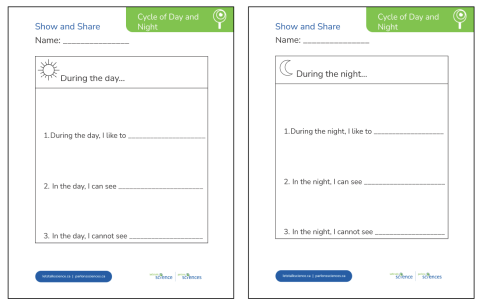
|
IdeaStudents could use the images from centre activity one to complete this activity, by taping images that correspond to the questions. LanguageAdd potential responses to the questions to a word wall. These could be in multiple languages. |
|
Have students write and draw images that answer the questions. Once finished, have students bring their sheets and sit in a circle. Have students who completed day sheets alternate with students who completed night sheets (to mimic the cycle of day and night). Have students take turns sharing their answers. |
IdeaIf students prefer not to share in front of their peers verbally, encourage them to hold their work up or share one-on-one at a later time. |
Background Information for Teachers
Day and Night
Cycles are an important concept in many disciplines. The cycle of day and night provides a context for students to compare and contrast daily routines at home, at school and in their communities.
By developing an understanding of the different activities and symbols associated with day and night, students are able to contextualize the two concepts. Students can further develop their understanding of day and night by learning about the Earth's rotation around the Sun.

Image - Text Version
Shown are two colour illustrations, side-by-side, of the same street, during the day and at night.
Each illustration has three tall houses, in a row. There is one tree to the left, and two to the right of the row.
In the left image, someone is sitting under the two trees. The sky above is light blue with a bright yellow sun and little white clouds. A rainbow curves from the bottom left corner, to the right side.
In the right image, no one is sitting under the trees. The houses are dark, but light shines from the windows. The sky above is dark purple with gold and white stars. A half-moon shines in the top right.
Additional Resources
Reproducibles
- What is a Cycle? slideshow [Google slides] [pptx] [PDF]
- Centre Activity 1 Images reproducible [Google doc] [Word doc] [PDF]
- Night-Day Spinner Activity Card reproducible [Google doc] [Word doc] [PDF]
- Night-Day Spinner Template reproducible [Google doc] [Word doc] [PDF]
- Night and Day - Show and Share reproducible [Google doc] [Word doc] [PDF]
Media
- Read aloud version of the book Day and Night by National Geographic
- Sun Up Sun Down by Gail Gibbons or read aloud version
Books
Sun Up, Sun Down: The Story of Night and Day
by Jacqui Bailey
What makes the sun rise and set? Our planet is spinning in a universe of sun, moon, and stars. See how the day unfolds in one family’s backyard in this story of Earth and sun.
Read aloud version here.
ISBN 9781404811287
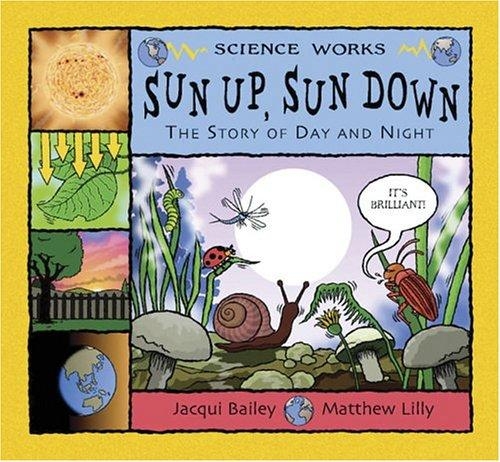
Lights Day and Night
by Susan Hughes and Ellen Rooney
This book follows a young girl’s exploration of light during the day and the night. This book focuses more on the science of light therefore it will be useful if students wish to know more about why we can see lights at all times of the day.
ISBN 13 9781525303197
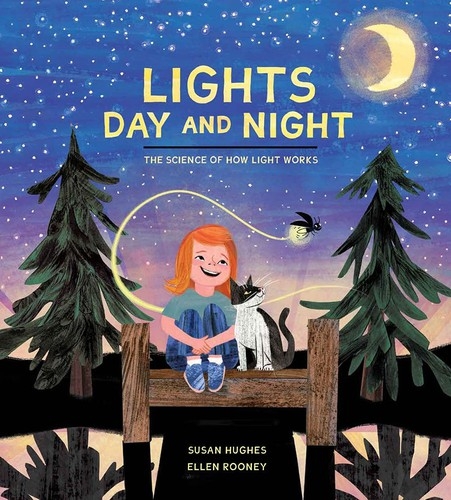
How Raven Stole the Sun by Maria Williams
A long time ago, Raven was pure white, like fresh snow in winter. A greedy chief had the stars, moon, and sun locked up in carved boxes. Raven transformed himself into the chief's grandson and tricked him into opening the boxes and releasing the starlight, moonlight and the sun. When he gets trapped in the chief’s house, Raven’s only escape is through the small smoke hole at the top.
Read aloud version here.
ISBN 9780789201638
For more context on this Indigenous connection (Tlingit Culture) watch this interview of author Maria Williams.
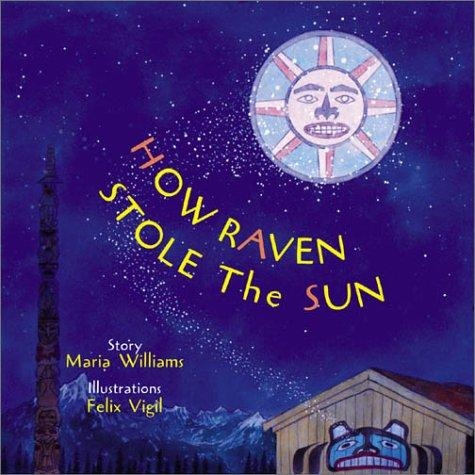
Videos
Day and Night (2021)
This video (10:18 min.) from Zest2Teach is a read aloud version of the book Day and Night by National Geographic. This book explores some of the things that happen on Earth during the cycle of day and night.
Sun Up Sun Down Gail Gibbons (2021)
This video (6:37 min.) from Christy Herris is a read aloud version of the book Sun Up Sun Down by Gail Gibbons that explains why we have day and night on Earth.
Reproducibles and Media
Reproducibles
- What is a Cycle? slideshow [Google slides] [pptx] [PDF]
- Centre Activity 1 Images reproducible [Google doc] [Word doc] [PDF]
- Night-Day Spinner Activity Card reproducible [Google doc] [Word doc] [PDF]
- Night-Day Spinner Template reproducible [Google doc] [Word doc] [PDF]
- Night and Day - Show and Share reproducible [Google doc] [Word doc] [PDF]
Media
- Read aloud version of the book Day and Night by National Geographic
- Sun Up Sun Down by Gail Gibbons or read aloud version
Books
Sun Up, Sun Down: The Story of Night and Day
by Jacqui Bailey
What makes the sun rise and set? Our planet is spinning in a universe of sun, moon, and stars. See how the day unfolds in one family’s backyard in this story of Earth and sun.
Read aloud version here.
ISBN 9781404811287

Lights Day and Night
by Susan Hughes and Ellen Rooney
This book follows a young girl’s exploration of light during the day and the night. This book focuses more on the science of light therefore it will be useful if students wish to know more about why we can see lights at all times of the day.
ISBN 13 9781525303197

How Raven Stole the Sun by Maria Williams
A long time ago, Raven was pure white, like fresh snow in winter. A greedy chief had the stars, moon, and sun locked up in carved boxes. Raven transformed himself into the chief's grandson and tricked him into opening the boxes and releasing the starlight, moonlight and the sun. When he gets trapped in the chief’s house, Raven’s only escape is through the small smoke hole at the top.
Read aloud version here.
ISBN 9780789201638
For more context on this Indigenous connection (Tlingit Culture) watch this interview of author Maria Williams.

Videos
Day and Night (2021)
This video (10:18 min.) from Zest2Teach is a read aloud version of the book Day and Night by National Geographic. This book explores some of the things that happen on Earth during the cycle of day and night.
Sun Up Sun Down Gail Gibbons (2021)
This video (6:37 min.) from Christy Herris is a read aloud version of the book Sun Up Sun Down by Gail Gibbons that explains why we have day and night on Earth.
Science
- Students could learn about animals that only come out at night as well as those that only come out during the day.
- Some places in Canada close to the North Pole have sunlight 24 hours a day at certain times in the spring and summer, and 24 hours of darkness throughout the winter months. If you live in one of these communities, how are your daily routines different in 24-hour sunlight and 24-hour darkness? If you don't live in one of these communities, describe how you think your routines would be different in 24-hour sunlight and 24-hour darkness.
Literacy
- Students could create day and night mini-flip books.
- As a class you could work together to create a poem about day and night that involves patterning (rhymes).
- Can also demonstrate patterns in words as students learn spelling patterns.
Mathematical Thinking
- Students could look for other examples of patterning using numbers.
- Extend into concept of ‘skip counting’ by the repeating patterns
- This also ties into directional thinking and geometry
Computational Thinking
- Students could do some basic ScratchJr activities.
Visual Arts
- Students could look at art works, such as Vincent Van Gogh’s Starry Night, and identify if the work represents day or night.
Extensions
Science
- Students could learn about animals that only come out at night as well as those that only come out during the day.
- Some places in Canada close to the North Pole have sunlight 24 hours a day at certain times in the spring and summer, and 24 hours of darkness throughout the winter months. If you live in one of these communities, how are your daily routines different in 24-hour sunlight and 24-hour darkness? If you don't live in one of these communities, describe how you think your routines would be different in 24-hour sunlight and 24-hour darkness.
Literacy
- Students could create day and night mini-flip books.
- As a class you could work together to create a poem about day and night that involves patterning (rhymes).
- Can also demonstrate patterns in words as students learn spelling patterns.
Mathematical Thinking
- Students could look for other examples of patterning using numbers.
- Extend into concept of ‘skip counting’ by the repeating patterns
- This also ties into directional thinking and geometry
Computational Thinking
- Students could do some basic ScratchJr activities.
Visual Arts
- Students could look at art works, such as Vincent Van Gogh’s Starry Night, and identify if the work represents day or night.
Sun: Sunset (Picture Collections)
Many people think the nicest time of day is when the sun is setting. Here are 5 images of scenes showing various sunsets.
Moon: Phases (Picture Collections)
Here are 8 images of different lunar phases showing the portion of the Moon lit by the Sun as the Moon orbits the Earth and as seen by us on Earth.
Why can we see shadows at night? (Hands-on Activities)
Take a walk after dark to find shadows.
How can I tell which way is north at night? (Hands-on Activities)
Do you like to look at the stars? What can you identify in the night sky? Try finding some important constellations tonight!
Learn More
Sun: Sunset (Picture Collections)
Many people think the nicest time of day is when the sun is setting. Here are 5 images of scenes showing various sunsets.
Moon: Phases (Picture Collections)
Here are 8 images of different lunar phases showing the portion of the Moon lit by the Sun as the Moon orbits the Earth and as seen by us on Earth.
Why can we see shadows at night? (Hands-on Activities)
Take a walk after dark to find shadows.
How can I tell which way is north at night? (Hands-on Activities)
Do you like to look at the stars? What can you identify in the night sky? Try finding some important constellations tonight!
Reproducibles
- What is a Cycle? slideshow [Google slides] [pptx] [PDF]
- Centre Activity 1 Images reproducible [Google doc] [Word doc] [PDF]
- Night-Day Spinner Activity Card reproducible [Google doc] [Word doc] [PDF]
- Night-Day Spinner Template reproducible [Google doc] [Word doc] [PDF]
- Night and Day - Show and Share reproducible [Google doc] [Word doc] [PDF]
Media
- Read aloud version of the book Day and Night by National Geographic
- Sun Up Sun Down by Gail Gibbons or read aloud version
Books
Sun Up, Sun Down: The Story of Night and Day
by Jacqui Bailey
What makes the sun rise and set? Our planet is spinning in a universe of sun, moon, and stars. See how the day unfolds in one family’s backyard in this story of Earth and sun.
Read aloud version here.
ISBN 9781404811287

Lights Day and Night
by Susan Hughes and Ellen Rooney
This book follows a young girl’s exploration of light during the day and the night. This book focuses more on the science of light therefore it will be useful if students wish to know more about why we can see lights at all times of the day.
ISBN 13 9781525303197

How Raven Stole the Sun by Maria Williams
A long time ago, Raven was pure white, like fresh snow in winter. A greedy chief had the stars, moon, and sun locked up in carved boxes. Raven transformed himself into the chief's grandson and tricked him into opening the boxes and releasing the starlight, moonlight and the sun. When he gets trapped in the chief’s house, Raven’s only escape is through the small smoke hole at the top.
Read aloud version here.
ISBN 9780789201638
For more context on this Indigenous connection (Tlingit Culture) watch this interview of author Maria Williams.

Videos
Day and Night (2021)
This video (10:18 min.) from Zest2Teach is a read aloud version of the book Day and Night by National Geographic. This book explores some of the things that happen on Earth during the cycle of day and night.
Sun Up Sun Down Gail Gibbons (2021)
This video (6:37 min.) from Christy Herris is a read aloud version of the book Sun Up Sun Down by Gail Gibbons that explains why we have day and night on Earth.
Reproducibles and Media
Reproducibles
- What is a Cycle? slideshow [Google slides] [pptx] [PDF]
- Centre Activity 1 Images reproducible [Google doc] [Word doc] [PDF]
- Night-Day Spinner Activity Card reproducible [Google doc] [Word doc] [PDF]
- Night-Day Spinner Template reproducible [Google doc] [Word doc] [PDF]
- Night and Day - Show and Share reproducible [Google doc] [Word doc] [PDF]
Media
- Read aloud version of the book Day and Night by National Geographic
- Sun Up Sun Down by Gail Gibbons or read aloud version
Books
Sun Up, Sun Down: The Story of Night and Day
by Jacqui Bailey
What makes the sun rise and set? Our planet is spinning in a universe of sun, moon, and stars. See how the day unfolds in one family’s backyard in this story of Earth and sun.
Read aloud version here.
ISBN 9781404811287

Lights Day and Night
by Susan Hughes and Ellen Rooney
This book follows a young girl’s exploration of light during the day and the night. This book focuses more on the science of light therefore it will be useful if students wish to know more about why we can see lights at all times of the day.
ISBN 13 9781525303197

How Raven Stole the Sun by Maria Williams
A long time ago, Raven was pure white, like fresh snow in winter. A greedy chief had the stars, moon, and sun locked up in carved boxes. Raven transformed himself into the chief's grandson and tricked him into opening the boxes and releasing the starlight, moonlight and the sun. When he gets trapped in the chief’s house, Raven’s only escape is through the small smoke hole at the top.
Read aloud version here.
ISBN 9780789201638
For more context on this Indigenous connection (Tlingit Culture) watch this interview of author Maria Williams.

Videos
Day and Night (2021)
This video (10:18 min.) from Zest2Teach is a read aloud version of the book Day and Night by National Geographic. This book explores some of the things that happen on Earth during the cycle of day and night.
Sun Up Sun Down Gail Gibbons (2021)
This video (6:37 min.) from Christy Herris is a read aloud version of the book Sun Up Sun Down by Gail Gibbons that explains why we have day and night on Earth.
Science
- Students could learn about animals that only come out at night as well as those that only come out during the day.
- Some places in Canada close to the North Pole have sunlight 24 hours a day at certain times in the spring and summer, and 24 hours of darkness throughout the winter months. If you live in one of these communities, how are your daily routines different in 24-hour sunlight and 24-hour darkness? If you don't live in one of these communities, describe how you think your routines would be different in 24-hour sunlight and 24-hour darkness.
Literacy
- Students could create day and night mini-flip books.
- As a class you could work together to create a poem about day and night that involves patterning (rhymes).
- Can also demonstrate patterns in words as students learn spelling patterns.
Mathematical Thinking
- Students could look for other examples of patterning using numbers.
- Extend into concept of ‘skip counting’ by the repeating patterns
- This also ties into directional thinking and geometry
Computational Thinking
- Students could do some basic ScratchJr activities.
Visual Arts
- Students could look at art works, such as Vincent Van Gogh’s Starry Night, and identify if the work represents day or night.
Extensions
Science
- Students could learn about animals that only come out at night as well as those that only come out during the day.
- Some places in Canada close to the North Pole have sunlight 24 hours a day at certain times in the spring and summer, and 24 hours of darkness throughout the winter months. If you live in one of these communities, how are your daily routines different in 24-hour sunlight and 24-hour darkness? If you don't live in one of these communities, describe how you think your routines would be different in 24-hour sunlight and 24-hour darkness.
Literacy
- Students could create day and night mini-flip books.
- As a class you could work together to create a poem about day and night that involves patterning (rhymes).
- Can also demonstrate patterns in words as students learn spelling patterns.
Mathematical Thinking
- Students could look for other examples of patterning using numbers.
- Extend into concept of ‘skip counting’ by the repeating patterns
- This also ties into directional thinking and geometry
Computational Thinking
- Students could do some basic ScratchJr activities.
Visual Arts
- Students could look at art works, such as Vincent Van Gogh’s Starry Night, and identify if the work represents day or night.
Sun: Sunset (Picture Collections)
Many people think the nicest time of day is when the sun is setting. Here are 5 images of scenes showing various sunsets.
Moon: Phases (Picture Collections)
Here are 8 images of different lunar phases showing the portion of the Moon lit by the Sun as the Moon orbits the Earth and as seen by us on Earth.
Why can we see shadows at night? (Hands-on Activities)
Take a walk after dark to find shadows.
How can I tell which way is north at night? (Hands-on Activities)
Do you like to look at the stars? What can you identify in the night sky? Try finding some important constellations tonight!
Learn More
Sun: Sunset (Picture Collections)
Many people think the nicest time of day is when the sun is setting. Here are 5 images of scenes showing various sunsets.
Moon: Phases (Picture Collections)
Here are 8 images of different lunar phases showing the portion of the Moon lit by the Sun as the Moon orbits the Earth and as seen by us on Earth.
Why can we see shadows at night? (Hands-on Activities)
Take a walk after dark to find shadows.
How can I tell which way is north at night? (Hands-on Activities)
Do you like to look at the stars? What can you identify in the night sky? Try finding some important constellations tonight!